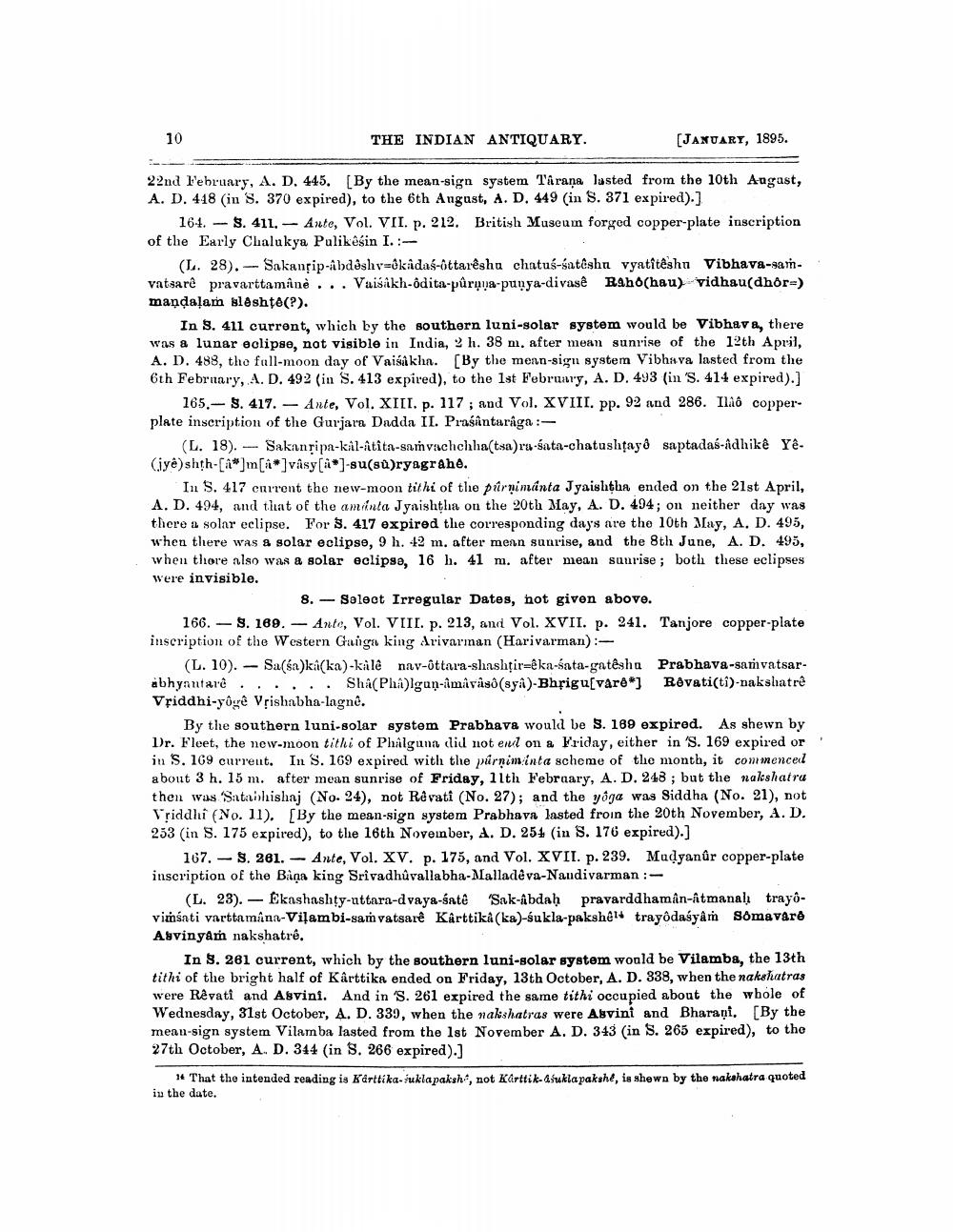________________
10
[JANUARY, 1895.
22nd February, A. D. 445. [By the mean-sign system Târana lasted from the 10th August, A. D. 448 (in S. 370 expired), to the 6th August, A. D. 449 (in S. 371 expired).]
164. - S. 411. Ante, Vol. VII. p. 212. British Museum forged copper-plate inscription of the Early Chalukya Pulikêśin I. :
(L. 28). Sakanrip-abdêshv-ôkâdas-ôttarêshu chatus-satêshu vyatiteshu Vibhava-samvatsarê pravarttamânè... Vaisakh-ôdita-pura-punya-divasê Baho(hau) vidhau(dhor=) mandalam slêshtê(?).
THE INDIAN ANTIQUARY.
In S. 411 current, which by the southern luni-solar system would be Vibhava, there was a lunar eclipse, not visible in India, 2 h. 38 m. after mean sunrise of the 12th April, A. D. 488, the full-moon day of Vaisakha. [By the mean-sign system Vibhava lasted from the 6th February, A. D. 492 (in S. 413 expired), to the 1st February, A. D. 493 (in 'S. 414 expired).]
165.-S. 417. Ante, Vol. XIII. p. 117; and Vol. XVIII. pp. 92 and 286. Ilâô copperplate inscription of the Gurjara Dadda II. Praśântaraga:
Sakanripa-kal-âtita-samvachchha(tsa)ra-sata-chatushtayê saptadas-adhikê Yê
(L. 18). - (iye)shth-[*]m[*]vâsy [*]-su(su)ryagrahê.
In S. 417 current the new-moon tithi of the purnimanta Jyaishtha ended on the 21st April, A. D. 494, and that of the amanta Jyaishtha on the 20th May, A. D. 494; on neither day was there a solar eclipse. For S. 417 expired the corresponding days are the 10th May, A. D. 495, when there was a solar eclipse, 9 h. 42 m. after mean sunrise, and the 8th June, A. D. 495, when there also was a solar eclipse, 16 h. 41 m. after mean sunrise; both these eclipses were invisible.
8. Select Irregular Dates, not given above.
166. S. 169.
-
- Ante, Vol. VIII. p. 213, and Vol. XVII. p. 241. Tanjore copper-plate inscription of the Western Ganga king Arivarman (Harivarman):
(L. 10). abhyantare Vriddhi-yogê Vrishabha-lagnê.
-
Sa(sa)ka(ka)-kalê nav-ôttara-shashtir-êka-sata-gatêshu Prabhava-samvatsarSha(Phi)lgun-âmâvâsô(sya)-Bhrigu[varê*] Rêvati(t)-nakshatrê
By the southern luni-solar system Prabhava would be S. 189 expired. As shewn by Dr. Fleet, the new-moon tithi of Phalguna did not end on a Friday, either in 'S. 169 expired or in S. 169 current. In S. 169 expired with the purniminta scheme of the month, it commenced about 3 h. 15 m. after mean sunrise of Friday, 11th February, A. D. 248; but the nakshatra then was Satabhishaj (No. 24), not Rêvati (No. 27); and the yoga was Siddha (No. 21), not Vriddhi (No. 11). [By the mean-sign system Prabhava lasted from the 20th November, A. D. 253 (in S. 175 expired), to the 16th November, A. D. 254 (in S. 176 expired).]
-
167. S. 261. Ante, Vol. XV. p. 175, and Vol. XVII. p. 239. Mudyanûr copper-plate inscription of the Bana king Srivadhuvallabha-Malladê va-Nandivarman :
(L. 23). Ekashashty-uttara-dvaya-śatê 'Sak-abdaḥ pravarddhamân-âtmanal trayôvimsati varttamâna-Vilambi-sam vatsarê Kârttika (ka)-sukla-pakshel trayôdasyâm Sómavarė Asvinyam nakshatré.
In S. 281 current, which by the southern luni-solar system would be Vilamba, the 13th tithi of the bright half of Kârttika ended on Friday, 13th October, A. D. 338, when the nakshatras were Rêvati and Asvini. And in 'S. 261 expired the same tithi occupied about the whole of Wednesday, 31st October, A. D. 339, when the nakshatras were Asvini and Bharani. [By the mean-sign system Vilamba lasted from the 1st November A. D. 343 (in S. 265 expired), to the 27th October, A. D. 344 (in S. 266 expired).]
14 That the intended reading is Kärttika-suklapaksh, not Karttik-asuklapakshe, is shown by the nakshatra quoted
in the date.




